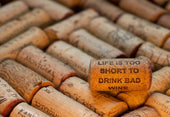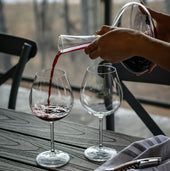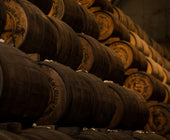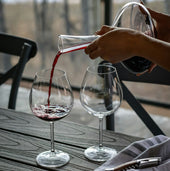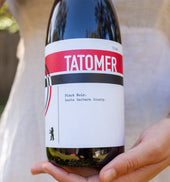
Making Sense of Wine Scores

There are wine reviews, and then there are wine scores. Ostensibly, consumers have time to read the often beautifully written review before noting the score and making an informed purchase decision based on review, price and score. Most wine publications describe their scoring method in great detail — and nearly all of them point out that the score alone does not reflect the relative quality of a wine.
However, wine buyers are bombarded with wine scores in the absence of complete reviews. Magazine advertisements with breathtaking bottle-shots shout out 90+ point scores in bold type, along with the name of a well-known wine critic. Box stores are flagged with shelf-talkers (those slips of paper next to the price on the shelves), and neckers (collars on the bottles themselves) boasting 90+ points followed by two or three generic callouts such as “lush and vibrant” or “well structured”. Unless you are an avid follower of two or three wine publications, that number is nearly meaningless without context.
Moreover, anything below 90 points is rarely mentioned. Depending on the scoring rubric, 87 points could be a very good buy or a don’t waste your money purchase. Another puzzle piece is the source of the review. Is 90 points from your local newspaper the same as 90 points from a renowned wine publication? Not surprisingly, the answer is: it depends. If you live in wine country, a local review may be even more compelling than what someone in New York City thinks about a particular bottle.
This article will attempt to compare the apples-to-oranges scoring systems of the following wine publications: Wine Spectator, Robert Parker’s Wine Advocate, Wine Enthusiast, Vinous, James Suckling and Jancis Robinson.
A matter of scale:
Most reviewers use a 100 points scale. It’s in base 10, easily understandable to those of us who attended US schools, and, with a few variations, aligns well with the A through F format that we’ve internalized. We all know that a failing grade is usually below 60 or 50. So, isn’t the 100 point scale really a 50-point scale? Taking that one step further, isn’t the 100 point scale really a 5-step scale where A is excellent and F is a fail?
Other reviewers use 20 point scales that reflect the French higher education model where 20 is outstanding and below 10 is failing. This scale was developed for wine by UC Davis in the 1950s and is used by many British wine publications. Like the US, France just dumps half the points into the “fail” bin and divides the remainder into 5 blocks from exceptionnel to passable — in essence, a 6-step scale. Comparing 5 steps to 6, how hard could that be? Harder than you think.
Reviewers do not necessarily assign the same number of points into each step (think of grading on a curve where 93-100 is an A, 85-92 is a B, 80-85 is a C, etc.). This is how a wine score of 87 could indicate a great weeknight wine or a real dud, depending on the source.
There is hope. After reviewing the major wine sites' self-described scoring methods, and, with the additional guidance of this handy document (credit: www.delongwine.com), I offer the following primer.

Links to scoring method of each review source: Wine Spectator | Robert Parker’s Wine Advocate | Wine Enthusiast | Vinous | James Suckling | Jancis Robinson
The Take Home
A score is only a small portion of a wines’ story. A score of 90 points and above is something to brag about and should sell a wine. Further, a winemaker is unlikely to promote a score below 89, and an 85 point evaluation shouldn’t necessarily sink a vintage. When scanning reviews, take a moment to consider the source before rejecting a number that’s below the 90th percentile.
So much more to say
This article is about points and is not a critique of wine reviews. Each periodical or zine has vastly different methodologies for tasting wines –, a different ethos about their relationship to the wine industry and varying definitions of independence. They are all behind some sort of paywall to access reviews, requiring a certain level of commitment from consumers. Some pages promote advertising while others are strictly subscription based. Advertising isn’t necessarily bad and it is the model upon which print publications survived for decades. Those print publications that moved to the internet also have decades of back issues available for browsing—a huge value. Meanwhile, wine sites designed specifically for the internet tend to be more integrated with social media, browser friendly, and have innovative ways to share information through videos and blogs. The bottom line is that they all have valuable information in addition to the scores they award. As a wine review consumer, taking time to review how critics review will help you decide your level of commitment.
 Patty Lyn Tweten is a writer, graphic designer and vineyard owner. She is also a devoted fan of rosés having helped her husband make their own with the sagniée method. Instagram Linkedin
Patty Lyn Tweten is a writer, graphic designer and vineyard owner. She is also a devoted fan of rosés having helped her husband make their own with the sagniée method. Instagram Linkedin






